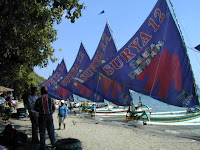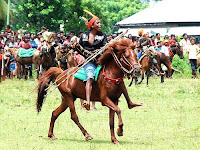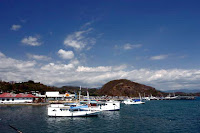South Kalimantan/South Borneo (Indonesian: Kalimantan Selatan often abbreviated to Kalsel) is a province of Indonesia. It is one of four Indonesian provinces in the Indonesian part of Borneo. The provincial capital is Banjarmasin. The province boundaries are Makassar Strait in the east, Central Kalimantan in the west and north, the Java Sea in the south and a small part of East Kalimantan in the north.
The province had a population of 2.97 million in 2000, which grew to 3,45 million by 2008. In 2008 the number of visitors to the province was 339,000 of which 21,000 were international visitors, mostly from China, Philippines and India.South Kalimantan is one of the 4 provinces in Kalimantan (formerly called Borneo).
It is often called the Province of a Thousand Rivers. One is Barito river, the largest and the longest river in Indonesia which is more than 6,000 km long.
One of its tributary rivers is the Martapura river, which in turn has two tributary rivers of its own, the Riam Kanan and Riam Kiwa rivers. Barito connects with the Negara rivers which branches out into lesser rivers.
In 1990 the total population of South Kalimantan was 2,463,792 with a growth rate of about 1.8 % annually. 54 % of the population earn their living from agriculture, 15 % from public services, 13 % from the commercial sector and the rest from industry, transport,
The minority consists of some Javanese, Maduranese, Banjau, Bugenese, Chinese and Arabs. The culture and traditions are the assimilation through ages of the indigenous Dayaks, Malays, and Javanese. Then came the influence of Islam which was introduced by Arab and Persian traders. This can be seen from the people's way of life, especially in arts, such as dance, music, traditional dress, games and ceremonies.
Handicrafts are made from local raw materials. Jewelry made of precious and semi-precious stones are mostly made and sold in Martapura.
Rattan and bamboo weaving are from the Tapin district, handicrafts made of gold, silver, brass and iron are from the Hulu Sungai Selatan region. Sasirangan is a specific textile design where its dyeing is a specially of South Kalimantan. The designs and method are different from those of other parts of Indonesia.
 Local fruits are among others : durian, rambutan, pineapple, etc.
Local fruits are among others : durian, rambutan, pineapple, etc.The high rate of rainfall and adequate sunshine have made South Kalimantan fertile. Extensive forests with a large variety of trees make South Kalimantan one among the large wood producers in Indonesia. The region is well-known for its iron-wood, meranti, pinus and rubber.
South Kalimantan is connected with cities all over Indonesia through Syamsuddin Noor airport which is 25 km from Banjarmasin.
South Kalimantan can also be reached through the seaport of Trisakti and Banjarmasin harbor. To towns in Kalimantan there are plenty of good roads.
If waterways are preferable, go by boat along large rivers which go to almost every direction.
________________________________________
PLACES OF INTEREST
Banjarmasin and its surroundings
Banjarmasin is one of the biggest cities and enough important in Kalimantan, broadly regional 72 km2, 45 districts and 49 sub-districts, Banjarmasin is the provincial capital of South Kalimantan. Town region Banjarmasin stay between three provinces that is: South Kalimantan Province, Central Kalimantan Province, and East Kalimantan Province.
 Banjarmasin city has written in world map since four centuries ago. During the Dutch colonization Banjarmasin city is area with autonomy and have representative area. And that take place is finite a period of Japan colonization. During transition (1945-1949) Banjarmasin become center power switchover since independence had proclamation. Banjarmasin now is preparing various areas covering: Administration, commerce, port town, education and tourism. Banjarmasin, the capital city, is the center of trade and tourism. It lies at the delta of the Barito river. The city is intertwined by numerous rivers of various sizes and lengths. The major rivers are Martapura and Nagara. The numerous rivers made the city get its nickname River City local people build traditional floating houses along the rivers and these houses are called "lanting", facing the rivers, which are made of wood or bamboo. Rivers have been very important for business and economic activities. This is one reason why there arefloating markets everywhere.
Banjarmasin city has written in world map since four centuries ago. During the Dutch colonization Banjarmasin city is area with autonomy and have representative area. And that take place is finite a period of Japan colonization. During transition (1945-1949) Banjarmasin become center power switchover since independence had proclamation. Banjarmasin now is preparing various areas covering: Administration, commerce, port town, education and tourism. Banjarmasin, the capital city, is the center of trade and tourism. It lies at the delta of the Barito river. The city is intertwined by numerous rivers of various sizes and lengths. The major rivers are Martapura and Nagara. The numerous rivers made the city get its nickname River City local people build traditional floating houses along the rivers and these houses are called "lanting", facing the rivers, which are made of wood or bamboo. Rivers have been very important for business and economic activities. This is one reason why there arefloating markets everywhere.Making trips along the mighty Barito and Martapura rivers by "klotok boat or river bus", will give a unique experience. For longer trips one can hire speedboat.
Banjarmasin has developed into an industrial and touristic city. There are star hotels and 20 lesser hotels. For entertainment there are 21 movie theaters, karaoke centers, cultural theaters and restaurants serving local as well as international foods.
Kembang Island
This island is right in the Barito river, not far from a floating market. It is a conservation forest of about 60 hectares, inhabited by tame monkeys of Kalimantan species only. One of the species is called "bekantan" (nasalis larvatus).
It is mostly visited by Chinese Indonesians, as there is a small offering temple where they feed the monkeys.
It is believed that feeding the monkeys will bring good luck an fortune.
Kaget Island
Like Kembang island, Kaget island is also in the Barito river. From downtown it takes 1 1/2 hours by klotok boat or 1 hour by speedboat to get there.
This island is another forest conservation and is also inhabited by the "bekantan" monkeys and the Lutung (prebitis orisate), as well as many sorts of birds.
Diamond Digging at Cempaka & Martapura
Martapura is the capital of the Banjar regency, 36 kilometers southeast of Banjarmasin.Martapura, particularly the Cempaka district, is a well known producer of diamonds.Several mining villages exist, such as Lukaas and Sungai Tiung, lying five kilometers from Martapura.
People can be seen panning for diamonds at villages in the Cempaka district, eight kilometers from Martapura. Panners usually work in groups. Each group consists of the 16 to 18 people. The oldest person is usually named the head of the group. Before starting to work, they ask for guidance from "the expert one" the spirit of the village - so they will be led to the richest mining grounds.
First, the panners have to come to an agreement with the owner of the land, who has the right to 10 percent of the diamonds found. Then, several people are chosen to dig a hole, while others remove the soil or remove any water from the hole with buckets or with a pump. The holes are usually six to 10 meters deep. The sides are propped up with logs to prevent them from collapsing. As long as no diamonds are found, the digging continues in a horizontal direction so that tunnels are formed.
They work without schedule. It can start in the morning and continue until midnight, under the light of lanterns. Deposits are usually found at depths of 10 to 15 meters, in rocky earth layers. The dirt is taken out and washed. If diamonds are found, the head of the group must immediately be notified. The right to offer the diamond for sale belongs the group leader only.
In the past, it was strictly prohibited to talk to the person washing the gored. According to the local belief the diamonds become frightened and hide among the grains of sand. Women are strictly forbidden to step over the pits. The rough diamonds are referred to as "virgins".
South Kalimantan diamonds are classified into four types: petrous diamonds (yellow and of low quality), black diamonds (black and believed to posses mystical powers), white diamonds and pink diamonds (the best sparkling with the colors of a rainbow).
The Trisakti diamond was the most expensive diamond ever found in this region. It weighed 160 carats and belonged to the pink diamond category.
Diamonds are cut and polished in the Diamond Market of Martapura. Such places are always better known than the sites where the diamonds are found. That is why Martapura is also known as Diamond Town. There are several well known experts in diamond processing in Martapura.Cempaka is a small village 10 km from Banjarbaru, and 45 minutes from Banjarmasin. It is an old site of traditional diamond digging using very simple equipment.
The digging is a collective work by a group, usually consisting of one family and its close relatives.
In 1985 a large raw diamond of 116.7 carats was found in a hole of 15 meters deep.
Martapura is the center of diamond and precious stones polishing; it is also the center of diamond marketing. The town is 40 km from Banjarmasin.
The polishing work uses traditional as well as modern equipment.
Martapura Plaza is the center of diamond and jewelry marketing. Stone-craft of various origins and forms are easily found in the markets of Martapura.
Pieces of jewelry having with a large price range, start from as little as Rp.500,- up to millions of rupiahs.
Takisung Beach
Hulu Sungai Tourist Resort
Hulu Sungai is a vast region in the northern part of the province. Most areas here are swamps, but the eastern part is mountainous.
Loksado
Loksado is at the South Hulu Sungai district whose capital is Kandangan. The town is about 3 hours by car from Banjarmasin. The road is good. However, from Kandangan to Loksado, the road goes as far as Halunuk, a small village. Then the trip continues by motor cycle which takes a single passenger over a narrow foot-path.
The natural surroundings of the hilly region provides attractive sights for those who enjoy hiking and mountaineering. On the way, meet the local people with their original ways and cross the river over a suspended bridge.
Adventure River Rafting
The Amandit River which originates at Meratus runs through Loksado and meets the mighty Barito river further down.
Visitors usually use the river to get back after visiting Loksado. Those who enjoy rafting may venture the trip through numerous rocky rapids by traditional rafts made of bamboo or by rubber boats. The river trip starts at Loksado, 45 kilometers from Kandangan. When a motorcycle ride is preferred, it takes about 4 hours. Those who enjoy trekking through the forests of the hill, the trip takes 8-10 hours.
When a river trip is taken, start from Loksado to Batu Laki which is 56 km away. The trip can be made in two stretches. The first is from Loksado to Muara Hatip. The second is from Muara Hatip to Batu Laki.
The first stretch is not very challenging because the rapids are not very strong and ranks as grade 1 to 2 1/2. On the second one, the level of difficulty increases, while the rapids are higher and stronger at grade 3, such as Hawangan and Kandihin at the mouth of the river Muara Haring. The panorama along the river is fascinating.
________________________________________














































